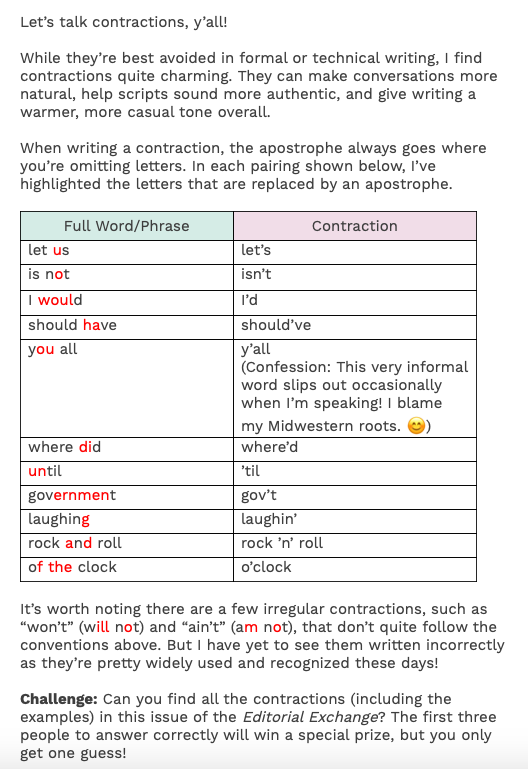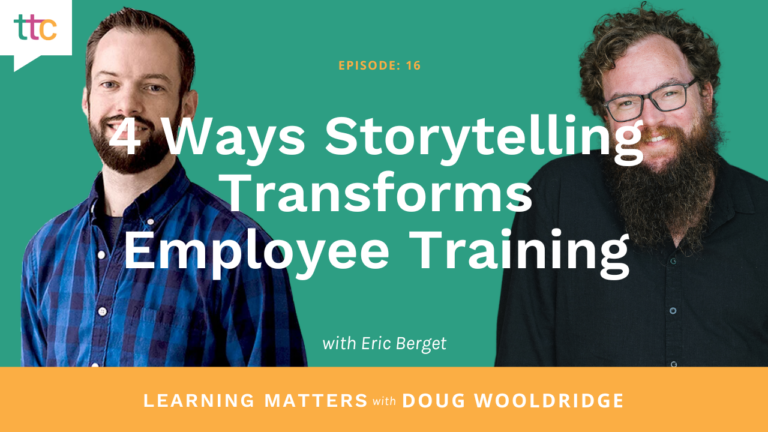Though I don’t consider myself a professional instructional designer by any stretch of the imagination, I’ve still managed to absorb several training and development principles over the years while editing myriad learning deliverables created by expert Innovators. Through this lens, I saw an opportunity to educate others on the importance of good grammar. When I proposed a bi-weekly email series sharing editing and writing tips a couple years ago, I didn’t realize I was about to embark on a microlearning journey of my own.
Here are five things I’ve learned about developing a microlearning lesson or series — no matter the topic!
1. Make it short and sweet.
This is microlearning, after all! Consider Twitter. Their 280-character limit (previously only 140) is proof that you can still get maximum impact out of a minimal format if you choose your words carefully. There are two common approaches to developing microlearning:
- Start small by determining the core learning objective and building on that concept. In microlearning, there’s really only room for one objective. Any related objectives or topics should be reserved for separate components. Add only essential details that directly support your learning objective.
- Start with a larger, existing chunk of content and trim off as much excess material as you can without stripping away that core objective. Example: “We here at ABC Company believe that, when done right, training is the key to a successful product rollout,” can become simply “Training is the key to a successful product rollout.”
Other ways to get more bang for your buck when space is limited include bullet lists with straightforward, quick-hit points; dos and don’ts or pros and cons (any kind of “this versus that” approach) for topics that have distinct black-and-white categories; and pictures, icons, or even emojis to get the point across in fewer words.
2. Make it irresistible.
Apply marketing and journalism tactics to entice your learners from the opening line. Aim for a title that makes them feel like they’re missing out if they don’t continue. (Take a look through ttc’s blog for some headline inspiration!)
The more casual, personal serving size format of microlearning usually means more freedom of expression as well. Choose eye-catching visuals and coordinating colors when possible (like we did in this Safety Regulation flier for Amazon). In these busy times, you only have a few moments to capture the recipient’s attention. The best microlearning should engage learners before they even realize it!

One FREE Week!
New clients, tap into our talent with one week of Innovators on Demand® on us.
Get started with one of our skilled Innovators.
3. Make it relevant.
We’ve covered grabbing their attention, but how do you retain it? If you want your learners to keep coming back for more, it doesn’t matter how flashy the content looks — the subject matter needs to be valuable too. Make it worth their time to read! Even if someone is already familiar with a topic, you can still make the lesson worthwhile by approaching it from a unique perspective or including tips and tricks they might not have discovered yet. And while microlearning isn’t the ideal learning solution for complex subjects, it can be used supplementally to reinforce concepts introduced during more in-depth instructor-led or web-based training.
Another way to draw your audience in is to reference current events. If you can connect your topic to something that’s happening in the here and now, the learner will be better equipped to apply the lesson to real-life events. Or try appealing to their emotional side by pulling inspiration from your own experiences. One of my favorite tactics is what I like to call the “Seinfeld approach,” where I start a lesson off with “Have you ever been in X situation?” Then I proceed with a solution to that common conundrum. Connecting with people through shared experiences is surprisingly effective!
4. Make it accessible.
Whether you’ve opted for an email blast, a series of social media slide decks, or a standalone PDF, ensure your bite-size training is easy to find. Keep an archive library of related microlearning lessons for readers to come back to in case they missed a lesson or want a refresher. Bonus: If the lessons “live” in an online document repository or website, you can reference and link out to past issues in new editions to strengthen your point and increase the learner’s chances of recalling that information in the future.
5. Make it fun!
Above all, microlearning should be enjoyable! The closer your audience is to feeling like they’ve just taken a fun break from work, the better. Consider how you can engage your learners quickly – short-form games and quizzes (with or without an incentive) are extremely effective for the competitive types.
In the example below from my Editorial Exchange series, I did a mini scavenger hunt where readers had to find all the contractions in the issue. The first three to get the right number were given a choice between a gift card or one hour of editing (from yours truly) free of charge.

This issue resulted in the most engagement by far of all my lessons, and a few of the incorrect answers gave me an opportunity to provide more targeted guidance, such as how to spot the difference between a possessive and a contraction.

On-Demand Webinar
The Five Guiding Principles of Effective Microlearning: When and where to incorporate microlearning into your training strategy.
Microlearning is generally more cost-effective and quicker to develop than traditional long-format eLearning, making it an attractive option for clients looking to pack a punch with a limited timeline and budget. To learn more about microlearning, check out our webinar on The Five Guiding Principles of Effective Microlearning. This webinar is hosted by master instructional designer Kesha Dougan, who inspired me to create the Editorial Exchange series!
What topic can you transform into a magical microlearning experience?







